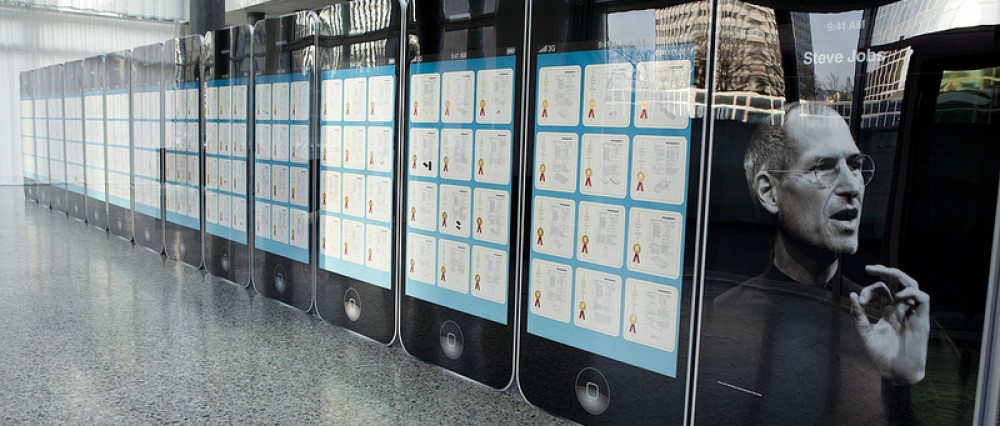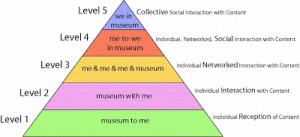Prior to the 1970s, museums focused on the collection, upkeep and recording of items in their collections. Barbara Franco, former director of The Historical Society of Washington, quipped that museums were in the “salvage and warehouse” business (Weil, 1999). During the 1970s a paradigm shift occurred and museums began to see their mission as directed towards people. While museums in the 19th and early 20th were satisfied with a relatively small number of visitors from an elite class, now they have a broader mission and strive to draw visitors from all ethnicities, and income levels (Weil, 1999). Consequently, museums are now in the business of education, conversation, collaboration and sharing as well as collecting, organizing and preserving (Proctor, 2010). Early attempts to better reach the public took the form of devising entertaining ways to showcase the collection (Watkins and Russo, 2007). Social media allow museum staff to communicate beyond the walls of the museum reaching people who may never visit, but who may want to engage with the museum staff, collection or people sharing an interest in the museum.
Social Media and the New Museum Paradigm
Whereas in the past museum staff worked behind closed doors with little interaction with visitors, social media allows for immediate communication that can build the democratic relationship museums now seek (Bailey, 2009). When used effectively, social media provide an ideal means of connecting with the public in a meaningful way as to promote and hold exhibits (Bailey, 2009) or solicit donations.
All museums must realize that even if they reject social media, their users haven’t (Proctor, 2010). Visitors record and discuss their museum experiences in blogs, on Facebook, Twitter and other social media. For example, the Flickr Group “At the Museum” has almost 3000 members and over 87,000 photos (Flickr, 2013). To balance a museum’s duties to its public with its duty to its collection, Nancy Proctor explains that “museums need to reconcile the apparently contradictory views of democratizing control and preserving and valuing expertise” (2010). In the era of Web 2.0 Lynda Kelly believes museums need to:
“share authority, take risks, give staff and communities permission to experiment and play . . . encourage connections and networks both internally and externally, provide scaffolding and support that others can work from . . . allowing third parties to access their material and see what eventuates, acknowledge that a healthy community will self-monitor and self-correct take their place as the subject matter experts, while also drawing on the power of their collective communities” (2010).
Data on Museums’ Use of Social Media
In a recent online survey of 315 American museums using social media, Adrienne Fletcher and J. Lee Moon learned that 94% of surveyed museums used Facebook, 70% use Twitter, 56% use YouTube and 49% use Flickr (2012). While 60% of the respondents use social media to list events and post reminders, many museums use social media for online promotions, to reach out to a larger audience, or for conversation with stakeholders (Fletcher and Moon, 2012). Chris Alexander’s team of researchers examined the YouTube use of five museums and found that all five museums reported that You Tube videos “have helped introduce new audiences to their museum, have helped [their] core audiences get a closer connection to programs and services, and have helped to explain a difficult topic/concept/artist in a way that other resources couldn’t” (2008).
Effective Use of Social Media
Since social media is analogous to a cocktail party, users don’t want to be ill-mannered guests who simple tries to sell, sell, sell (Bailey, 2009). Sophisticated social media users ask questions, amuse, educate and enlighten those they communicate with. (Bailey, 2009). As social media is casual and somewhat intimate, institutions that simply post press releases and event listings, “just don’t get it” (Kidd, 2011). Nina Simon illustrates the kinds of interaction in a hierarchy she developed for museums’ social media use.
As the pyramid grows steeper, the interaction between the museum and its users gets more interactive, more democratic; control is shared In the best cases, a museum reaches “the holy grail of social discourse, where people interact directly with each other around content” (Simon, 2007). Effective social media use should ideally capitalize on the strengths of each platform. Examples of successful social media implementation include Tweetups, events for users who promise to document their visit (Preston, 2011), changing rules regarding photography, and allowing visitors to upload their videos on the museum’s YouTube channel and website (Kidd, 2011).
Ethics of Social Media in Museums
In using social media, a museum staff must consider ethical questions concerning accountability, censorship, and transparency. For example, how can museums, such as the U.S. Holocaust Memorial Museum, reconcile the ideal of free speech with its mission to honor and memorialize a people? (Wong, 2011). The often casual tone characterizing much social media is at odds with the seriousness required of some exhibits. Some museums note the friendly nature of microblogs and their personnel use their own names on Twitter. Although Wong was assigned to tweet or the U.S. Holocaust Museum, she was not hired to be its spokesperson. Consequently, the museum decided not to allow her to tweet under her own name (2011). Each museum needs to consider their reputation, audience and responsibilities in creating and implementing a policy of social media ethics (Wong, 2011).

